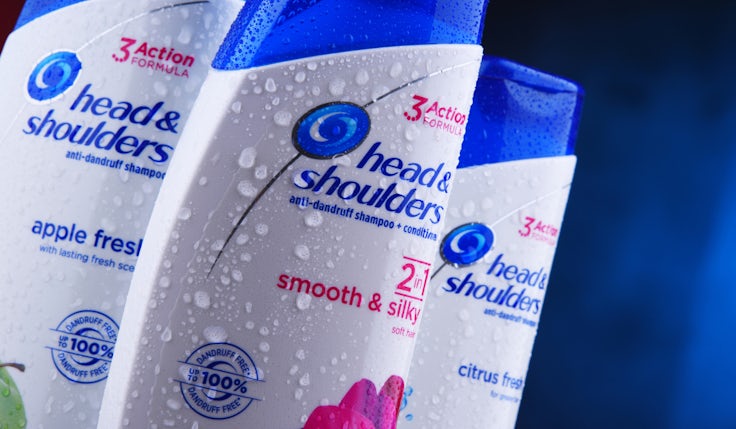Inside Gillette’s bid to build a billion-dollar franchise
Kicking off its biggest ever UK launch, the Procter & Gamble-owned brand is looking to “modernise” its image with a “high impact” campaign for the new Gillette Labs razor.
Gillette is rolling out its “biggest ever” UK launch campaign in a bid to turn its experiential-focused Labs brand into a billion-dollar franchise.
“The plan is to make this the biggest launch the UK has ever seen, even bigger than our Fusion launch back in 2005, which was previously our biggest launch in the UK and has since become a billion-dollar franchise,” explains Gillette brand director Callum Wood.
A product of Gillette Labs, the brand’s premium innovation hub, the new razor boasts a built-in exfoliation bar designed to make shaving more effortless. The launch is backed by a major campaign rolling out across TV, outdoor, a takeover of Gillette Soccer Saturday and tie-ups with influencers including football star Raheem Sterling and Formula One driver Lando Norris.
The visual identity of the new razor is focused on contrasting black and neon green. Wood explains that with a big campaign having consistent assets is critical, as is choosing an identity that will cut through. The marketers believe the colour combination is equally impactful on a billboard, TV ad or social media. During concept tests the brand identity was proven to have “stopping power” when scrolling through a social feed.
“Because we knew the razor was a very different proposition to what guys have seen in the market today, we knew we needed to do something different. The colours are very much a part of that,” Wood states.
While DTC is important, it’s the lifeblood of the data and insights, still a massive part of what will make the success of this is the traditional retail partners.
Callum Wood, Gillette
Going forward Gillette wants to get to a point where men associate different colours with different products in the portfolio and the benefits they deliver. The team wants to build a mental shortcut where neon green stands for exfoliation, while orange is clearly associated with the Fusion product.
“The basic objective has been to turn the UK black and neon green. We want every single guy to see this product multiple times, to the point where they can’t move for seeing Gillette Labs,” says Wood.
The intention is to strike a balance. Gillette has opted for “high impact, traditional media touchpoints”, such as TV spots during coverage of major sporting occasions and a takeover of London’s Piccadilly Lights, which will feature the first 3D razor men can interact with in real life. Wood describes this as a traditional media mix with a modern angle.
“The other piece is using digital and data to personalise our messages, especially for younger consumers, with a message that resonates for them in a channel they’re more likely to be in,” he adds.
“We’ve been modernising our media mix through the years and, as channels like TikTok grow in prominence, we need to make sure that we are playing across the wide range.”
Gillette launches premium division with first heated razor
The Gillette brand director points to the partnership with Norris’s Quadrant gaming collective, a gaming and lifestyle brand that is building an esports community of pro-players. The idea has been to bring the ‘Effortless’ campaign to life in the gaming space, with content specific to a younger demographic.
Wood admits it is becoming more complex to reach men because they’re on a greater variety of digital platforms, from TikTok to Instagram and Twitch, which means creating content and finding ambassadors tailored to their diverse interests.
“A huge part of the complexity and size of the campaign is trying to have all those different messages for the right audience,” he says.
“Someone who has been shaving for 30 years might have grown up with a Mach 3 razor and traded up to a Fusion. They will respond to a very different message, because they know what shaving is about, than an 18 year old guy who maybe has never used a razor before, so we need to adapt the messaging to what’s most relevant to them.”
Building hype
Ahead of launch the Gillette Labs razor already had a 100,000 strong waiting list. Wood explains it was important to build this list in order to create hype around the launch, the first time the Gillette marketers have taken this approach.
The aim was to have the messaging around the exfoliating razor live for months, pushed out online and via influencers. The marketers conducted research, profiling the types of consumers who could be early adopters.
“They’re more likely to be innovators, to be urbanites and we created these profiles of people we thought want to get their hands on it first. We used the data and digital approach to try and find those consumers and appeal to them to come to our waiting list and sign up,” says Wood.
“That has given us a wealth of learnings in terms of, how can we then create the right messages when we launch? So, if we put a message out there that no one decided to click on, we know guys aren’t responding to that.”
He characterises the creation of the waiting list as a form of in-market testing, on top of the additional consumer testing. The goal was to gain as much understanding as possible from consumers on what would work ahead of the product going live.

The waiting list was hosted on the Gillette Labs direct-to-consumer website, which Wood describes as an important channel for the business. Having the DTC arm gives Gillette the chance to gather data and insights on how consumers purchase, which in turn helps convince retailers the product is right for the market.
“Clearly the success of this campaign relies on our retail partners, our big customers who we work together with to launch our products. Without that the campaign would be no success. We’re delighted at how excited and bought in they are with the campaign,” says Wood.
“While DTC is important, it’s the lifeblood of the data and insights, still a massive part of what will make the success of this is the traditional retail partners both online and offline.”
When it comes to measuring the success of the campaign in both the short and long term, there is obviously the clear need to drive sales. On top of that is the goal of modernising the brand look and feel, getting more men who have never bought Gillette before, or are lapsed customers who stopped shaving, to purchase.
“The rigorous consumer research we do to try to bring a product with relevance, hopefully that transfers through to the campaign we bring to life and guys feel that and say ‘Gillette, really understands me. They’ve got a product that genuinely meets a need I have and therefore I’m willing to buy’,” says Wood.
“That is the ultimate success, which then leads to the sales, but really getting the brand to be more relevant and desirable to guys would be the success both short and long term.”
Innovation’s perfect storm
With Covid restrictions easing, Wood is convinced now is the “perfect time” for a launch of this scale. He explains that under lockdown there was a “massive trend change” in grooming, as social interactions fell off a cliff and working from home ensued.
However, as the UK announces plans to lift all restrictions in a bid to live with Covid, the grooming sector is building “brilliant business momentum.” Kantar statistics show razor blade sales rose by 14% in the 12 weeks to 23 January.
“We see consumers are going back to using shaving products, going back to shaving as they’re going back to normal life, which is why we thought this is the right time for our biggest ever launch,” Wood says.
The team have been working on the Gillette Labs razor for three years. Every day 80 consumers visit P&G’s Reading facility and are observed through two-way mirrors trying different shaving concepts, in order to gain feedback on their changing shaving habits.

Wood explains research and development and marketing have a joint interest in the insight. The concept for the Gillette Labs razor came from “extensive” consumer research showing shaving is a chore for most men.
“We’ve been on a mission to make that process more effortless, which is really the key element we’re communicating with this campaign. It’s the razor itself which turns the shaving process from what could be a chore into something that’s a bit more experiential,” Wood adds.
Every element of the product was perfected over the three-year period. The R&D team tested 60 different forms of the scallops on the razor’s exfoliating bar, for instance, to find the most effective design. The Gillette Labs razor also comes with a magnetic stand to hold it upright, enabling the five blades to dry fully. The razor’s launch is being supported by a wider Labs product push, including a quick rinse shave foam and rapid foaming shave gel.
“It’s a case of even if we have the razor in a place where it’s ready to go to market there’s always work to be done in terms of verifying that with consumers, figuring out the right concept, the right communication angle to bring to market,” Wood says.
“We tend to make sure we’re doing things right rather than rushing, bringing something and losing out on what could be a huge opportunity for us. We clearly wanted to make sure everything was in the right place before we went to market.”
Gillette uses football to promote ‘positive versions of masculinity’
Working with Nielsen, the razor and wider brand concept has tested in the top 5% of consumer goods launches. The consumer testing is, in fact, better than any Gillette launch in history, including 2005’s Fusion razor. This level of consumer acceptance gives Gillette the confidence that the context, product and concept has created the “perfect storm” for the razor’s launch.
The fact the razor’s handle boasts a lifetime guarantee suggests the brand is leaning into the premium credentials of the Gillette Labs range, in a bid to differentiate from competitors in the disposable razor sector.
“What we want to do with the razor is drive that reassurance of quality. We want that message to hit home to guys that this could be the last razor you ever have to buy and therefore if you tried to do the maths in your head this is an amazing value proposition,” Wood explains.
The Gillette Labs brand launched in 2019 with a heated razor designed to mimic a wet, hot barber shave. P&G is trying to establish Labs as the experiential, innovation driven strand of the Gillette portfolio.
That being said, the model is not for Gillette Labs to be the only platform bringing innovation to market, the intention being to create products that meet different budgets and grooming styles. Wood points to the King C Gillette beard care range, skincare range Gillette Skin and Skin Guard, a razor specifically designed for men with sensitive skin.
Offering “shaving plus experience” is the idea to help the Labs products stand out. The exfoliating bar, for example, is built into the razor rather than the blades to combine the benefits of a close shave with exfoliation.
“That’s the whole premise of Labs,” says Wood. “It turns what is very functional into an experiential element of shaving.”







